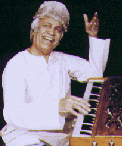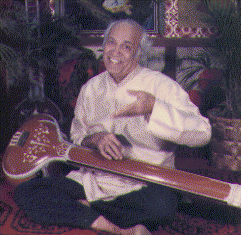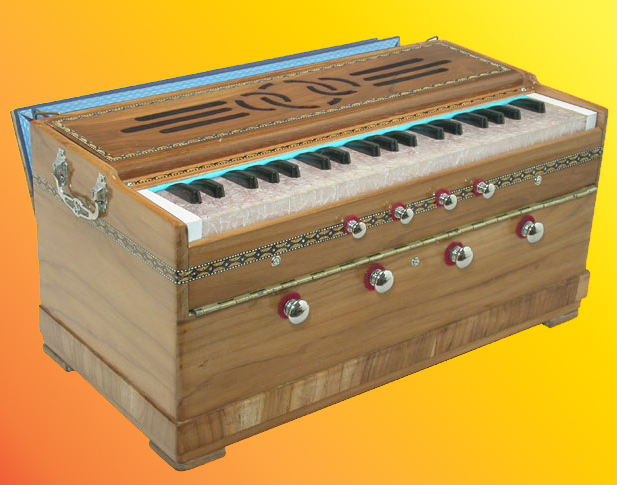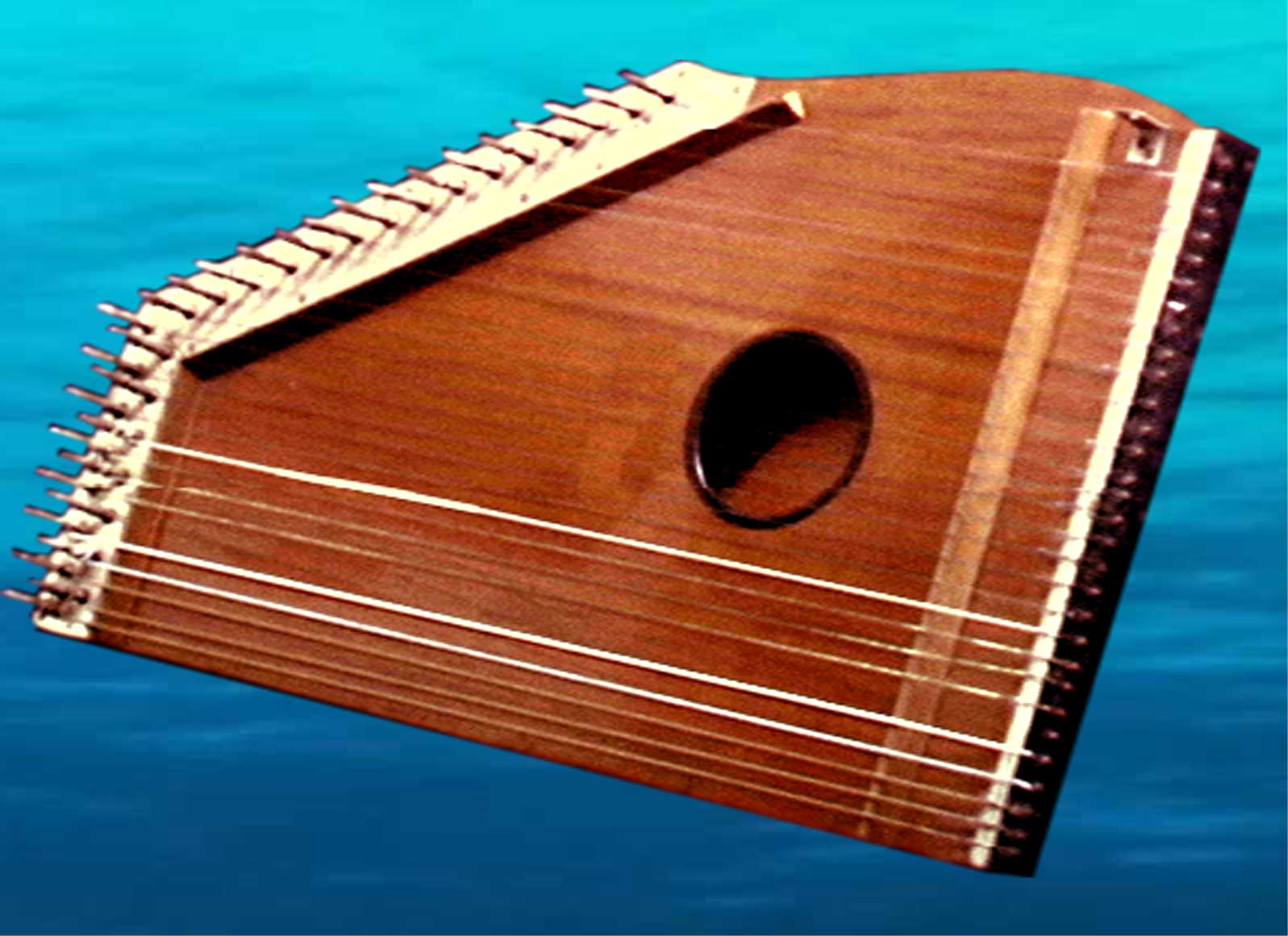Pandit Shiv Dayal Batish
Raga Manavati
Ashwin Batish and family Live
The UC Theater, Berkeley, California.
Meena Batish
Words by Ghalib
Music by S.D. Batish
Phone: (831) 423-1699

Singing Lesson #1
by Pandit Shiv Dayal Batish
The most important requisite to singing is the health of your vocal chords. I will discuss how to keep them in perfect shape. Also, I will talk on the proper handling of three of the most popular instruments used for the accompaniment of Indian singing - the tanpura, the swarmandal, and the harmonium.
- Cleanliness is next to godliness:
First and foremost, one should
look after the cleanliness of one's body. This applies more to a vocalist
than to any other vocation. It is wise to make a habit of taking
a bath early each morning.
- Sleep cycle: A well regulated sleep cycle is very important. Extremes of too much sleep or excessive wakefullness is also derogatory to general health. This will affect the proper functioning of the throat. A hoarse voice is often the result of staying awake very late at night.
- Smoking & Drinking: Keep your lungs free from any contaminants. Smoking habitually can reduce your lung capacity and eventually lead to a hoarse voice. Drinking liquor before practice or performance can hinder your intonation and slur your speech.
- Dental Hygiene: Keep your teeth and your tongue clean with regular brushing and flossing, preferably after each meal.
- Energy Maximization: Over indulgence in any activity can be detrimental to your vitality. A vocalist should try not to indulge in too much sex. Loosing energy in this manner weakens the body and mind. Ultimately this will affect your power of thinking and performance.
Performace Tips
Center Yourself
Take a deep breath and concentrate on the center of your cerebrum. This is spiritually addressed as the "ISHT" or the favorite deity. You can also call it the "Muse", or the "Ultimate." The general idea is to bring the active side of one's thinking around to the emotive side of the "Naada" sound coming suggestively from the tanpura's drone.Now gently try to sing the A-U-M (OM) sound on the tonic note, Sa. Sing the vowels in a long, elongated period of time, without getting breathless. Keep concentrating on that central point. Repeat this process as many times as you can, making sure and taking care that the voice is in perfect unison with the drone sounds coming from the tanpura.
In the begining your voice might tend to falter. Your vocal muscles are still in a stationary mode. But gradually, with regular repetitions, the muscles will get stronger and start producing an emotion filled tone without cracking or getting out of tune. Try to eliminate the oscillation which comes naturally in the voice. Actually, this is the main idea of practice with the tanpura - to control the oscillation at will and release it when required, without straying from the actual tone.
After a while, as the timbre of your voice is well established, on Sa, start adding a consonant sound by uttering a consonant from something familiar to you. Here is a Sanskrit chant used in ancient times:
TWAM................DHANANTA...............HARI
meaning
THOU..............ARE INFINITE........OH GREAT LORD!
You can sing this in whole or in parts. It is at your discretion. Relax and carefully concentrate on bringing emotional effect to your voice.
Here are some more syllables we use in singing. They have no meaning but fit extremely well in vocalization. Similar to how jazz scat singers.
The point to remember is to use the sylables to help establish the identity of the raga under practice.
As the voice gains alertness and energy, it is time to add another note to the Tonic, Sa. Let's make this a "Shudha Re", the natural second. Concentrate on this note for a while. Make sure you connect the "Re" as you strike the 5th note "Pa" of the Tanpura. This interval should harmonize perfectly. Keep connecting, both sounds for a while, use the "TOM NOM" consonants freely.
Add another note to the mix. Let this be the third note "Shudha Ga". With two notes, you can make two variations i.e. 2x1= 2. Now with 3, you can create as many as six variations also known as "tans" or "alankaars" 1x2x3=6. Mix and match the three notes in a way that pleases you. Make an attractive musical phrase. Feel its energy. Keep finding as many variations as you can between these notes.
Now add another note to the set. You can now make 4X3X2X1 = 24 variations. Keep up the process of combining and harmonizing. A feeling of exhilaration will start coming over you. Enjoy this enlivened, happy atmosphere. The fruits of your labor. The meditation point is reached. The sound form of a raga called Bhoopali has established its presence. You have actually sung the three notes from the lower tetrachord of this penatonic raga.
Here is the Arohi/Avarohi of Raga Bhoopali remember
Arohi = Ascending
Avarohi = Descending
Raga Bhoopali

More Hints
Keep the ascending and descending movements (Arohi and Avarohi) in mind as you progress. Add the notes of the upper tetrachord to the mix, one at a time. Create your own musical phrases. Whenever possible, take the guidance of a teacher in your locality. Try to acquire as may CDs, records, or cassettes by masters, past and present, who are performing this raga. Study their compostions and their approach to improvisation. It will be enlightening.
Now let's look at some of the popular accompanying musical instruments.
Tanpura
There are several preferred positions for holding a tanpura the main criterea is to be comfortable in holding it and to get ready to sit there for a long time. If you ignore these issues, you will have problems arising such as body cramps, legs going to sleep and a general discomfort that will destroy the whole experience. Tanpura players are a very valuable part of an Indian performance ensemble but their job is repetitive and often they have to sit very poised and very quietly. Performers that end up playing their own tanpura are more animated and in many cases they are more comfortable due to years of experience sitting on the floor and performing. Students generally need to be broken in.Sitting Position: Here are illustrations of two popular positions. All instructions given here apply to a right handed player. Left handed players should just reverse everything. For tuning, the tanpura should be laid down horizontally. This gives easy access to all the tuning pegs and tuning beads.

|

| Horizontal Position | Vertically Held Position |
Now you are ready to start playing this instrument. Gently bring the tanpura close to yourself. Take your pick of the horizontal or vertical positions shown above.
The horizontal position
This position is attained by gently laying the gourd side of the Tanpura to your right with the string's side facing up upwards.Hold the instrument firmly with your left hand under the gourd or gripping the left side of the face plate near the tuning beads. Your left hand can then be used to move the beads for tuning. Some Tanpuras are unstable in this position and will tend to roll away. So be sure to hang on. Your right hand should be completely free ready to play the strings.
The vertical position

While squatting, hold the tanpura vertically with the gourd placed on the ground in front of your crossed feet. The long shaft of the tanpura can then be placed on your right shoulder. Take care to safeguard the gourd from sliping or striking against any hard objects nearby especially as you bring the gourd of the Tanpura down towards the floor. Sometimes the distance to the floor can be misjudged and the gourd ends up hitting the ground. This can crack it.
Jawari
Check the Jawari threads under each string. Try to change these often. Slide them around until you get the most resonant setting. If you are not familiar with Jawari, read the previous article (RagaNet Issue #1) on this subject.Strike sequence
Once you've done this and are comfortable with the grip, and the instrument feels stable in your hands, place the thumb of your right hand on the right side of the long shaft somewhere close to the middle. Strum the strings in a sequence Pa/Sa/Sa/Sa. Start with your middle finger on the first string and follow it with your index playing the next three remaining strings.Do not strike the strings harshly. This can generate jarring and disproportionate overtones. Instead, be gentle. Try pressing on the strings with the soft skin of the right tip of your middle and index fingers. As it slips and releases the string, it produces a soft reverberant tone. This will make the sound emnate with a mellow and rich timbre. It will also blend well with your voice. Let each string reverberate while you strike the next in a slow deleberate manner.
Tanpura Tuning
There are two main tunings to consider - Sa/Pa and Sa/Ma. Some tanpuras with 5 or more strings can allow some more creative tuning possibilities.The choice between the two is made by the raga you'll be performing. Ragas such as Bageshwari, Malkauns, Abhogi, Gunkali, etc have the fourth as a Vadi or Samvadi and has a strong draw on the Sa/Ma relationship. But other ragas as Todi, Kalyan, Puriyadhanashri etc. With Vadi notes Dha komal, Ga, Pa, etc will require the Sa/Pa tuning.
Then there are ragas that don't have a 4th or a fifth in its progression, like the raga, Marava. Here a third is a good choice.
Certain ragas, like "Pooriyaa" of Marvaa Thaat, have the seventh note Ni (Nishadha) as the Vadi. Here the note maneuvers end up on the lower Ni and vocalists might choose to tune the Pancham wire to this note.
Once your instrument is completely tuned you are ready to start your vocal practice. If you like, you can even give the tanpura to another player, who can sit next to you or behind you during performance or practice.
Tanpura Tuning Tips
Make sure the two middle strings of steel are tuned perfectly. Even a slight difference in intonation can be very distracting. Pick a key in which you are able to sing in a gamut of about two and a half octaves. You might need a pitch generater to help your tuning process. If you have a piano, harmonium or other keyboards use them as reference. If nothing is available, buy a good electric tone generator or a shruti box (drone keeper), preferably one aligned with international tuning standards. This will help also you in any future recording or performance projects.Strum each string and check its intonation with the reference tone. If any of the strings need further adjustments try to twist the pegs slowly while getting the feel of the tone. Use the main pegs to come close to the note but alway try to do the final fine tuning by using the beads. Stop when the result is satifactory and move on to the next string.
One thing you should keep in mind is that, with all accoustic instruments, your tuning can change unpredictably. Temperature, moisture, just lifting the tanpura, or simply tuning an adjoining string can cause a change. Ideally you should fine tune your instrument in the performing position. So keep at it. It might take a few attempts. But finally you will have the instrument tuned perfectly.
When all the four strings are set, check the Jawaari threads again, and try to optimize the sound resonance.
Harmonium Accompaniment
 While the tanpura is the best at keeping your shrutis in perfect tuning, Indian musicians have for many years now adopted a Western inspired instrument called the harmonium to use for self-accompaniment.
While the tanpura is the best at keeping your shrutis in perfect tuning, Indian musicians have for many years now adopted a Western inspired instrument called the harmonium to use for self-accompaniment.
Since its introduction to the India via the early Christian missionaries, the harmonium first was introduced in the shape of a pedal organ. I can just imagine that its constant droning sustain filled tone must have attracted the Indian musicians's ear and we soon had an instrument maker modifying the pedal organ by removing the pedals and sticking the bellows to the back of the instrument hence allowing for the instrument to be played while squatting on the floor with one hand pumping the air and the other playing the music. The instrument was a wild success and is today found in almost every musical household. Although the classical singers are still reserved and adamant towards the harmoniums inherent Equal Temperament tuning, Many of the folk, light classical, instrumental and ghazal singer have adopted this instrument despite its short comings.
If you use the Harmonium for accompaniment, know which notes sound the worst when you are woking on singing ragas. The clash is very obvious when playng major thirds and major 6ths. The major 2nds can be jarring if you sings raga in Sa/Ma tunings.
While the harmonium has the drawbacks mentioned, what it brings to the table is hassle free pre-tuned notes that a singer can quickly start the song with. Tanpura needs constant attention. A hard plucking action, temperature variations, or just the lifting of th einstrument from lying on the ground to holding upright can render it enough out of shruti purity of pitch that it can be disturbing to sing with. Harmoniums can also allow the musician to play melodic phrases hence it can be used to fill in the instrumental breaks unlike in a tanpura which can only give a constant drone sound.
Swarmandal Accompaniment

The Swarmandal's origins are very old. It's original name in our shastras is the "Achal Veena" meaning a stringed instrument that has no moving notes or a fixed pitch instrument. "Achal" literally mean "not movable."
In ancient times, one of the functions for this instrument was to be used as a tuner. All 22 shrutis could be tuned on a 22 note swarmandal and then the correct swaras could be selected for each raga. Facinating story that makes sense. Today, this instrument has found a home with classical singers that will strum it like a harp and also selectively pick the notes they are singing to create a rich and intonationally purer accompaniment than a harmonium. Bade Gulam Ali Khan sahib was probably the most famous singer to regularly use this instrument.
I have also used it for my riyaz and it really gave me some good ideas. For instance, if you are on sa and your hand wonders off to a dha, the voice quickly can maneuver to Dha as the note of the swarmandal rings out. Unlike the ease of action in a harmonium where you can actually play the melody you are singing, a swar mandal is best used for helping one align their voice accurately to the note being sung.
In conclusion, I personally own all three the Tanpura, the harmonium and the swarmandal. I would recommend all to you if you want to take on the task of learning to sing. They all have their pros and cons, but in the end, you will benefit from them all.
Good luck to you and happy practicing.....
Yours musically,
Issues:
1 • 2 • 3 • 4 • 5 • 6 • 7 • 8 • 9
|
|
|
email: info [at] batish.com
copyright ©1995 - Present Time ---- Batish Institute. All rights reserved. Intended For Personal Use Only. No part of the information here may be reproduced or utilized in any form or by any means, electronic or mechanical, including photocopying and recording, or by any information and storage retrieval system, without specific written permission from the Batish family.